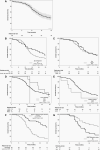Systematic review of diffuse hemispheric glioma, H3 G34-mutant: Outcomes and associated clinical factors
- PMID: 36105387
- PMCID: PMC9466272
- DOI: 10.1093/noajnl/vdac133
Systematic review of diffuse hemispheric glioma, H3 G34-mutant: Outcomes and associated clinical factors
Abstract
Background: A comprehensive review and description of the clinical features that impact prognosis for patients with diffuse hemispheric glioma, H3 G34-mutant (G34-DHG) is needed. Understanding survival and prognostic features is paramount for clinical advancements and patient care.
Methods: PubMed, Embase, and Google Scholar were searched for English articles published between January 1, 2012 and June 30, 2021. Eligible studies included patient(s) of any age diagnosed with an H3 G34-mutant brain tumor with at least one measure of survival or progression. Patient-level data were pooled for analyses. This study was prospectively registered in PROSPERO (CRD42021267764) and Preferred Reporting Items for Systematic Reviews and Meta-Analyses guidelines were followed.
Results: Twenty-seven studies met the criteria with a total of 135 patients included. Median age at diagnosis was 15.8 years (interquartile range [IQR]: 13.3-22.0) with 90% having localized disease. Co-occurring alterations included ATRX mutation in 93%, TP53 mutation in 88%, and MGMT promoter methylation in 70%. Median time-to-progression was 10.0 months (IQR: 6.0-18.0) and median overall survival was 17.3 months (95% CI: 15.0 to 22.9). The median time from progression to death was 5.0 months (IQR: 3.0-11.7). Factors associated with survival duration were age, as patients ≥18 y/o demonstrated longer survival (hazard ratio [HR] =2.05, 95% CI: 1.16 to 3.62), and degree of upfront resection, as near or gross-total resection demonstrated longer survival compared to those with less than near-total resection (HR = 3.75, 95% CI: 2.11 to 6.62).
Conclusion: This systematic review highlights available clinical data for G34-DHG demonstrating poor outcomes and important prognostic features, while serving as a baseline for future research and clinical trials.
Keywords: H3 G34-mutant; diffuse hemispheric glioma; outcomes; survival.
© The Author(s) 2022. Published by Oxford University Press, the Society for Neuro-Oncology and the European Association of Neuro-Oncology.
Figures


References
-
- Schwartzentruber J, Korshunov A, Liu XY, et al. Driver mutations in histone H3.3 and chromatin remodelling genes in paediatric glioblastoma. Nature. 2012;482(7384):226–231. - PubMed
LinkOut - more resources
Full Text Sources
Research Materials
Miscellaneous
